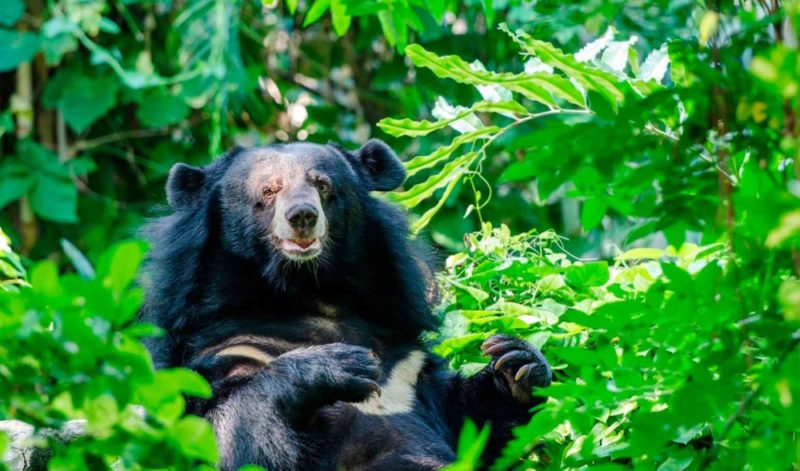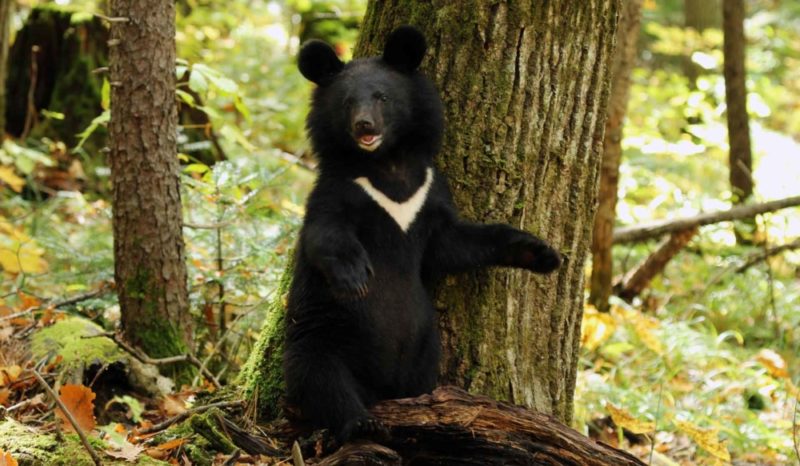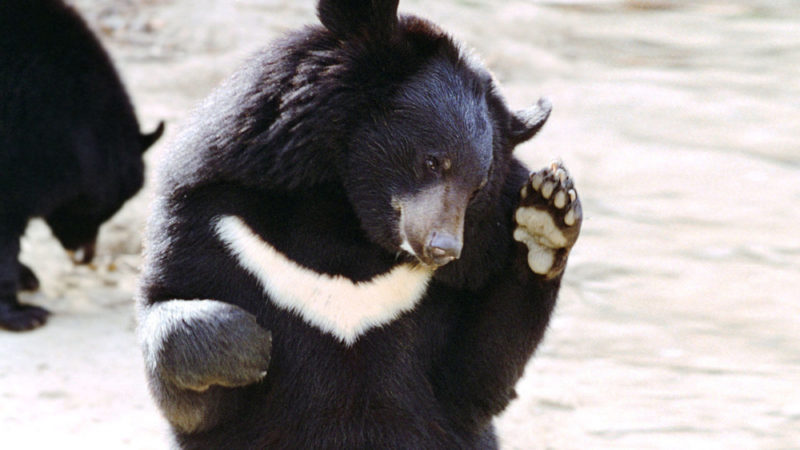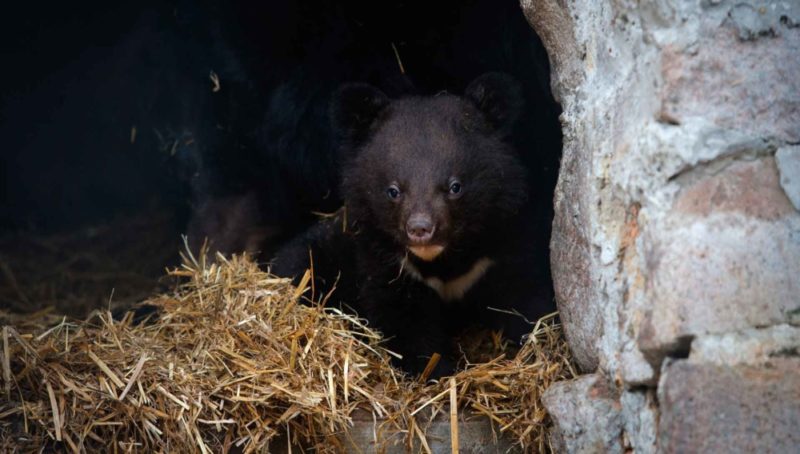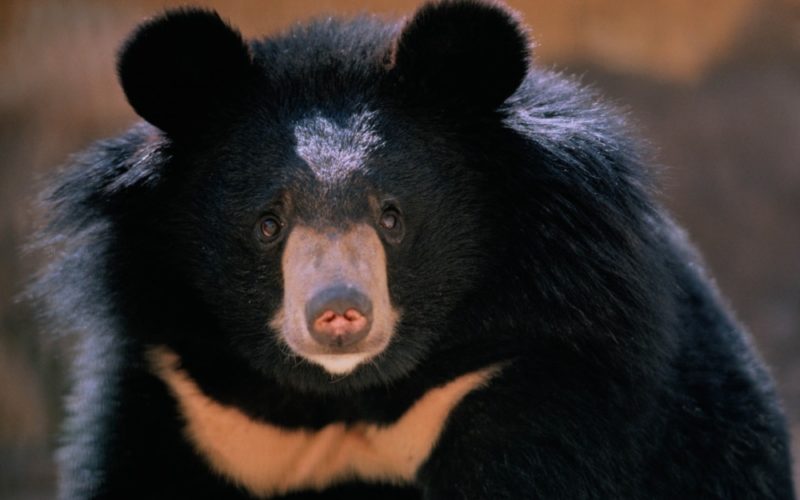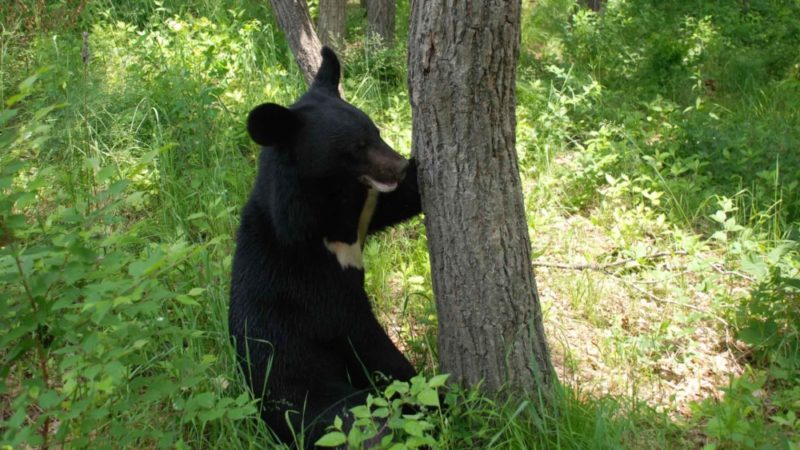Bears are massive and unusually beautiful representatives of the wild. In addition to the fairy-tale hero, the brown bear, familiar to us from childhood, there are several more varieties of this beast. One of them is the Himalayan bear.
Material Content:
Description and features of the Himalayan bear
The Himalayan bear is called the "black Ussuri bear." Also, in view of the features of its appearance, the beast is called a white-breasted bear.
This animal has significant differences from the brown bear familiar to Russian people:
- So, the white-breasted bear has a large head with a sharp muzzle, a flat forehead and a protruding ears.
- The hind limbs are slightly weaker than the front.
- An adult bear weighs about 140 kg, its growth reaches about 170 cm. Females are smaller - with a height of 160 cm, they weigh about 120 kg.
- The fur of animals is black-brown, brilliant, thick, silky, magnificent. The head of the beast is especially fluffy, because of which the front of its body appears to be larger than the back.
- A white patch of wool is located on the neck of the animal, in shape resembling the Latin letter V.
- The limbs end with curved sharp, but not long claws. Their convenient shape helps the bear easily move through the trees.
- The tail of the white-breasted bear reaches 11 cm.
It is interesting. The black Ussuri bear is also often called the lunar, and all because of the peculiar crescent on the black chest.
Lifestyle & Habitat
The Himalayan bear lives in Russia, namely in the Primorsky and Khabarovsk territories and the Amur region. This animal is also widespread in the northeast of China, in Korea, Japan.The range of the Himalayan bear is quite extensive: the beast lives in the highlands of Iran, in Pakistan, Afghanistan, as well as in the Himalayas.
Black-toed creatures spend most of their lives on trees, where they find it easier to get food and escape from natural enemies. These animals are able to climb a tree up to 30 m high. In a matter of seconds, they can descend to the ground, fearlessly jumping from branches 6 m high.
Did you know? Climbing a tree, the white-breasted bear is conveniently located between the branches, breaking them off and enjoying the fruits. After the meal, the beast places itself under it, forming a nest, which it subsequently uses for relaxation.
Like other bears, black Ussuri bears hibernate in winter. The shelter is the hollow of tall trees (at least 5 m), most often linden or poplar. If the bear failed to find a large tree for its placement, it lies in caves or hollows at the roots of the trees. Like all its brethren, a sleeping bear of a dark color does not excrete feces and urine. During the wintering period, moon bears significantly lose weight.
Ussuri black bears wake up at the end of April and often migrate, leaving the place of wintering and going to deciduous forests and vice versa. Interestingly, animals use the same route for their movements.
Did you know? The Himalayan bears are the owners of perfect memory and remember both the evil done and the good shown to their person.
The mood of these bears is unstable, often changing in an instant: the beast can be peaceful, and after some time become aggressive.
The white-breasted bear is a lone beast with the exception of the mating season. These animals also recognize the hierarchy, which largely depends on the weight and age of the bears. So, males, whose weight does not exceed 75 kg, are not always allowed to mate by females.
Population and species status
A black bear is considered a vulnerable species mainly due to deforestation and the value of some of its body parts.
White-breasted representatives of the bear family are listed in the Red Book in some countries of the world, in particular, in Vietnam and Russia.
- In the Russian Federation, in addition to poaching, there is a tendency for the growth of forest industry enterprises. The result is deforestation, which deprives the moon bears of their main habitat. The latter, as a result, are forced to settle in the rocks or on the ground, which makes them potentially vulnerable to hunters and brown bears.
- In Pakistan, clubfoot is considered an endangered species.
- This animal is also protected in China and India, however, due to the imperfection of the reforms, the offenders of bears are extremely difficult to hold accountable.
- In Japan, poaching for black bears flourishes, because in this country they are considered pests that spoil farmland.
Note. One of the countries where captive moon bears are officially allowed in captivity is South Korea.
According to 2009 information, about one and a half thousand individuals of these animals lived on special bear farms created for keeping animals for slaughter.
Animal nutrition
Most of the diet of the moon bear is plant foods: berries, nuts, tree buds and their leaves. At the same time, the Himalayan bears eat not only ripe, but also unripe fruits, differing in this from their brown counterparts. One of the most favorite treats of the clubfoot is considered bird cherry, the berries of which these bears are able to eat, it seems, endlessly.
White-breasted bears can ruin an apiary by stealing honey. Endowed with remarkable intelligence, bears often lower the hive into the river to reduce the risk of being bitten by bees.
Black Ussuri bears "dabble" also with insects and larvae. Unlike many of their brethren, these clubfoots are not predators and do not like fish, but they never deny themselves the pleasure of eating carrion.However, there are data on white-breasted bears that lived in South Asia and attacked livestock.
Breeding and offspring
The mating season in bears occurs in June - August. Ursa bear cows from 200 to 240 days. Teddy bears are born in a den by a sleeping mother, most often this occurs in early spring or late winter. 1 or 2 babies are born, less often - 3 - 4. Cubs weigh about 400 g, grow quite slowly - in a month they are still completely helpless. By the end of spring, they get a little stronger and weigh about 3 kg.
Young bears become adults by 2 to 3 years.
Life span
In nature, moon bears live for about 25 years. The longest life expectancy in captivity is 33 years, although there is evidence of animals that have survived to 40 years.
Note. Scientists and naturalists are seriously concerned about the quantitative indicators of Ussuri bears in the world.
Nature lovers see a way out of the situation in stopping deforestation, as well as changing generations of hunters in the countries of South Asia. So, young hunters are much less interested in the Himalayan bear as an object of fishing than their predecessors.
Natural enemies
The Ussuri black bear may suffer from the attack of brown bears and tigers, as well as a pack of wolves or leopards. Eurasian lynx is considered dangerous for cubs.
Young bears often flee from a stronger enemy, climbing to the tops of trees and patiently waiting until the predator gets tired of chasing them, and he leaves. At the same time, adult white-breasted bears are able to repulse the attacker.
Himalayan bears try to avoid humans: hearing shots or smelling the biped, they take to flight. However, an angry beast can attack a person and, perhaps, even come out of the fray as a winner. This is especially true for damsels protecting their offspring. In such cases, she rises to her hind legs and steps on the person, pursuing him even after he takes flight.
Himalayan bear as an object of human fishing
Himalayan bear - a common target for poaching. Hunters are attracted by the value of his fur and internal organs. This is what causes the reduction in the number of these clubfoot creatures. In medicine in Asian countries, bear bile is equal in value to ginseng, as it is considered a strong tonic and anti-aging product. Catching bears is quite a profitable business, because 1 g of bile of these animals costs about $ 100. The Chinese add this liquid to local vodka called baiju.
Caught for the purpose of collecting bile, animals undergo a truly painful procedure. They are kept on special farms and enclosed in a cage. A catheter is inserted into the gallbladder of animals to extract bile. And although this procedure is not fatal, it gives the animal incredible suffering and often leads to liver cancer. Up to 100 ml of bile can be obtained from one bear per day. A suffering animal often attempts suicide, trying to bite its paws and cause heavy blood loss or break its head on the bars of a cage. The barbaric torture can last several years, and then the emaciated animal is killed by selling meat to catering establishments.
Note. According to the international environmental organization, about 10,000 forced animals are kept on the farms of China and Vietnam.
Activists and volunteers from the beginning of the 21st century managed to buy back about 200 moon bears in Vietnam and 500 in China. After rehabilitation, these animals were released into the wild.
Interesting Facts
A black bear with a white breast is a very interesting animal.
Watching him, naturalists revealed several interesting facts:
- The lunar bear is almost twice as large as the brown bear.
- The Himalayan bear is the record holder for the largest ears among all its brethren.
- A white-breasted bear can descend from the branches of a tall tree in 2 seconds.
In a bear hibernated, all metabolic processes decrease by half the norm. At the same time, his pulse decreases from 50 - 70 beats per minute to 9 - 12, and the body temperature becomes lower by 3 - 7 ° C.
Lunar bears are recognized as the smallest in size of their species. Even the most experienced acrobat will envy their ability to climb to heights with lightning speed. In recent decades, the population of these animals has declined significantly, in particular due to rash human activities in relation to wildlife.


